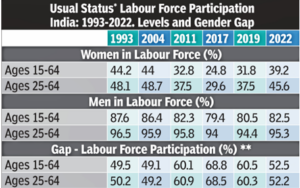ForumIAS announcing GS Foundation Program for UPSC CSE 2025-26 from 27th May. Click Here for more information.
Source: This post has been created based on the article “Mind The Gap, It’s Quickly Narrowing” published in The Times of India on 21st October 2023.
UPSC Syllabus Topic: GS Paper 3 Indian Economy Times of India— Indian Economy and issues relating to employment.
News: This article discusses the trends in of female labour force participation and wage gaps in India in the context of the recent Nobel Prize-winning research by Claudia Goldin.
A detailed discussion on Claudia Goldin’s research have been already covered in the following article: https://forumias.com/blog/nobel-prize-in-economics-2023-explained-pointwise/
There are two types of gender gaps according to Claudia Goldin:
First, women participate less in market work than men.
Second, women earn less than men.
These are considered critical for the economy by the IMF because a decline in these gaps contributes to “growth, resilience, financial stability and income equality”.
What is the paradox observed with respect to female LFPR in India?
With development and education, LFPR has gone upwards in most economies.
In India, both economic growth and female educational attainment had increased rapidly between 2004-05 and 2011-12. However, during the same period, Female LFPR in the Indian labour market declined.
The trend in FLFPR has not followed the increasing pattern estimated and forecast by Goldin.
Application of Goldin’s research: The accompanying table shows that regardless of the definition, FLFPR estimates for 2022-23 are very close to the 1993-94 estimates, thus confirming the Goldin ‘U’-shaped curve.
Source: Times of India
What is the status of the wage gap in India?
For ages 25-64, the gender wage gap is 30%. However, this wage gap does not adjust for education.
For all unmarried college degree workers, the wage gap is almost non-existent – only 3% (lower than the USA).
For all college educated workers, the wage gap is just 16% (again, lower than in the USA).
India has shown consistent improvement over the years in decline in the gender wage gap.
In conclusion, there is a labour force participation gap in India, but its level has been declining and is today very close to the level observed during 1993-2004, when India had a more liberal definition of female work.
The gender wage gap is low, and comparable to the best of the advanced countries, especially for college educated women.




